For the short term, some sideways movement was expected for Friday’s session, which is what has happened.
Summary: The low of December 2018 is expected to very likely remain intact, and this pullback is expected to be followed by a strong third wave up to new all time highs.
Two scenarios remain possible for the short term:
1. Some sideways movement continues before a final wave down to about 2,722 completes the pullback in two or three weeks time. A target calculated from the potential pennant pattern is about 2,690.
2. A pullback ends next week about 2,740 or 2,722.
A new wave count is published this week which considers the possibility that a relatively short lived bear market may have begun. The target is at 2,080. This wave count has a very low probability.
The biggest picture, Grand Super Cycle analysis, is here.
Monthly charts were last published here, with video here. There are two further alternate monthly charts here, with video here.
ELLIOTT WAVE COUNTS
The first two Elliott wave counts below will be labelled First and Second rather than main and alternate as they may be about of even probability. When the fifth wave currently unfolding on weekly charts may be complete, then these two wave counts will diverge on the severity of the expected following bear market. To see an illustration of this future divergence monthly charts should be viewed.
The new alternate Elliott wave count has a very low probability.
FIRST WAVE COUNT
WEEKLY CHART
The basic Elliott wave structure consists of a five wave structure up followed by a three wave structure down (for a bull market). This wave count sees the bull market beginning in March 2009 as an incomplete five wave impulse and now within the last fifth wave, which is labelled cycle wave V. This impulse is best viewed on monthly charts. The weekly chart focusses on the end of it.
Elliott wave is fractal. This fifth wave labelled cycle wave V may end a larger fifth wave labelled Super Cycle wave (V), which may end a larger first wave labelled Grand Super Cycle wave I.
The teal Elliott channel is drawn using Elliott’s first technique about the impulse of Super Cycle wave (V). Draw the first trend line from the end of cycle wave I (off to the left of the chart, the weekly candlestick beginning 30th November 2014) to the end of cycle wave III, then place a parallel copy on the end of cycle wave II. This channel perfectly shows where cycle wave IV ended at support. The strongest portion of cycle wave III, the end of primary wave 3, overshoots the upper edge of the channel. This is a typical look for a third wave and suggests the channel is drawn correctly and the way the impulse is counted is correct.
Within Super Cycle wave (V), cycle wave III is shorter than cycle wave I. A core Elliott wave rule states that a third wave may never be the shortest. For this rule to be met in this instance, cycle wave V may not be longer in length than cycle wave III. This limit is at 3,477.39.
A final target is calculated at cycle degree for the impulse to end.
The structure of cycle wave V is focussed on at the daily chart level below.
Within cycle wave V, primary wave 2 may not move beyond the start of primary wave 1 below 2,346.58.
In historic analysis, two further monthly charts have been published that do not have a limit to upwards movement and are more bullish than this wave count. Members are encouraged to consider those possibilities (links below summary) alongside the wave counts presented on a daily and weekly basis.
DAILY CHART
Cycle wave V must subdivide as a five wave motive structure. Within that five wave structure, primary wave 1 may be complete. Primary wave 2 may now continue sideways and / or lower as a zigzag, which may end within another one to few weeks. It is also possible that primary wave 2 was over at last week’s low although that scenario has reduced in probability.
Primary wave 3 must move above the end of primary wave 1.
When primary wave 3 is over, then primary wave 4 may be a shallow sideways consolidation that may not move into primary wave 1 price territory below 2,954.13.
Thereafter, primary wave 5 should move above the end of primary wave 3 to avoid a truncation.
Primary wave 2 may not move beyond the start of primary wave 1 below 2,346.58.
FIRST HOURLY CHART
It remains possible that primary wave 2 is incomplete and may be a longer lasting and deeper zigzag. This would have better proportion on the daily and weekly chart.
Intermediate wave (A) subdivides well as a five wave impulse.
This wave count allows for sideways movement for another one to two weeks before a final wave down to complete the pullback labelled primary wave 2.
Intermediate wave (B) may not move beyond the start of intermediate wave (A) above 2,954.01.
Intermediate wave (B) may be unfolding sideways as a regular flat correction. Within intermediate wave (B), minor wave B has met and passed the minimum requirement to retrace 0.9 the length of minor wave A. Minor wave B is between 0.9 and 1.05 the length of minor wave A, indicating a regular flat correction.
Regular flats often fit within trend channels and wave C is usually about equal in length to wave A.
Minor wave C within a flat must subdivide as a five wave structure, most likely an impulse. Within the impulse, minute waves i and ii may now be complete. Minute wave iii must subdivide as an impulse. Within minute wave iii, minuette waves (i) and (ii) may be complete. Minuette wave (iii) may begin on Monday and must move above the end of minuette wave (i).
If minute wave ii is not over and continues any lower, it may not move beyond the start of minute wave i below 2,805.49.
SECOND HOURLY CHART
This second hourly chart is identical to the first up to the low labelled intermediate wave (A). Thereafter, it considers a different structure for intermediate wave (B).
Intermediate wave (B) may continue sideways as a regular contracting or regular barrier triangle. For both possibilities, minor wave B may have continued lower to complete as a double zigzag. Only one of the five triangle sub-waves may subdivide as a multiple, and while wave C most commonly does this sometimes wave B may do so. All remaining sub-waves must now subdivide as single zigzags.
Within a regular contracting triangle (the more common type), minor wave C may not move beyond the end of minor wave A above 2,892.15. Thereafter, minor wave D may not move beyond the end of minor wave B below 2,831.29. Finally, minor wave E may not move above the end of minor wave C.
Within a regular barrier triangle (less common), minor wave C may not move beyond the end of minor wave A above 2,892.15. Thereafter, minor wave D should end about the same level as minor wave B at 2,831.29. A barrier triangle would remain valid as long as the B-D trend line remains essentially flat. This rule is the only Elliott wave rule which involves any degree of subjectivity. Finally, minor wave E may not move above the end of minor wave C.
A triangle may see price move sideways for another one to maybe two or even three weeks.
Elliott wave triangles are tricky structures to label correctly as they unfold, so some flexibility is essential with them. It is possible that labelling of this triangle may need to change again as price continues sideways. It is easy to label an Elliott wave triangle complete before it is so. Patience is required.
THIRD HOURLY CHART
It is possible that primary wave 2 is an incomplete zigzag, and within it intermediate wave (B) is complete. This wave count expects downwards movement this week to complete intermediate wave (C) and in turn complete the zigzag of primary wave 2.
Within intermediate wave (C), minor waves 1 and 2 may now be complete.
Minor wave 3 within intermediate wave (C) may have moved through the middle strongest portion. This agrees with MACD.
Minuette wave (iv) may not move into minuette wave (i) price territory above 2,851.11.
If intermediate wave (B) is complete, then bounces within intermediate wave (C) should find resistance at the upper edge of the black Elliott channel.
SECOND WAVE COUNT
WEEKLY CHART
This weekly chart is identical to the first weekly chart, with the sole exception being the degree of labelling.
This weekly chart moves the degree of labelling for the impulse beginning in March 2009 all down one degree. This difference is best viewed on monthly charts.
The impulse is still viewed as nearing an end; a fifth wave is still seen as needing to complete higher. This wave count labels it primary wave 5.
ALTERNATE WAVE COUNT
WEEKLY CHART
It is possible that for the second wave count cycle wave I could be complete. Primary wave 5 may be seen as a complete five wave impulse on the daily chart.
If cycle wave I is complete, then cycle wave II may meet the definition of a bear market with a 20% drop in price at its end.
Within cycle wave I, primary wave 1 was a very long extension and primary wave 3 was shorter than primary wave 1 and primary wave 5 was shorter than primary wave 3. Because primary wave 1 was a long extension cycle wave II may end within the price range of primary wave 2, which was from 2,132 to 1,810. The 0.382 retracement of cycle wave I is within this range.
Cycle wave II may not move beyond the start of cycle wave I below 666.79.
This wave count does not have support at this time from classic technical analysis.
TECHNICAL ANALYSIS
WEEKLY CHART
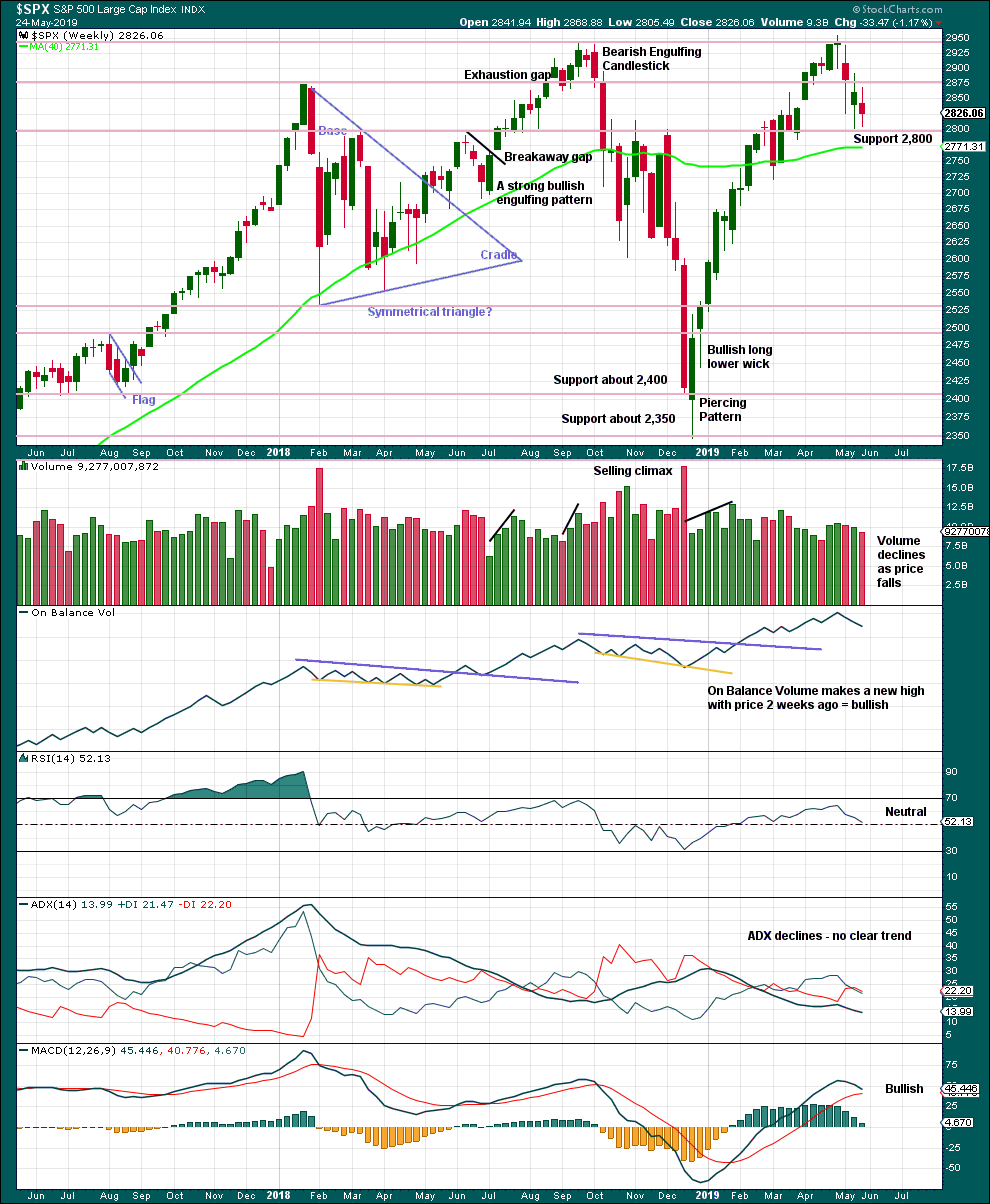
Click chart to enlarge. Chart courtesy of et=”_blank”>StockCharts.com.
There is an upwards trend from the low in December 2018, a series of higher highs and higher lows with a new all time high on the 30th of April 2019. While the last swing low at 2,785.02 on the 25th of March remains intact, then this view should remain dominant.
The trend is your friend.
This week closes red, but price has moved sideways. The balance of volume was downwards and volume is not pushing price lower. Overall, this is neutral.
DAILY CHART
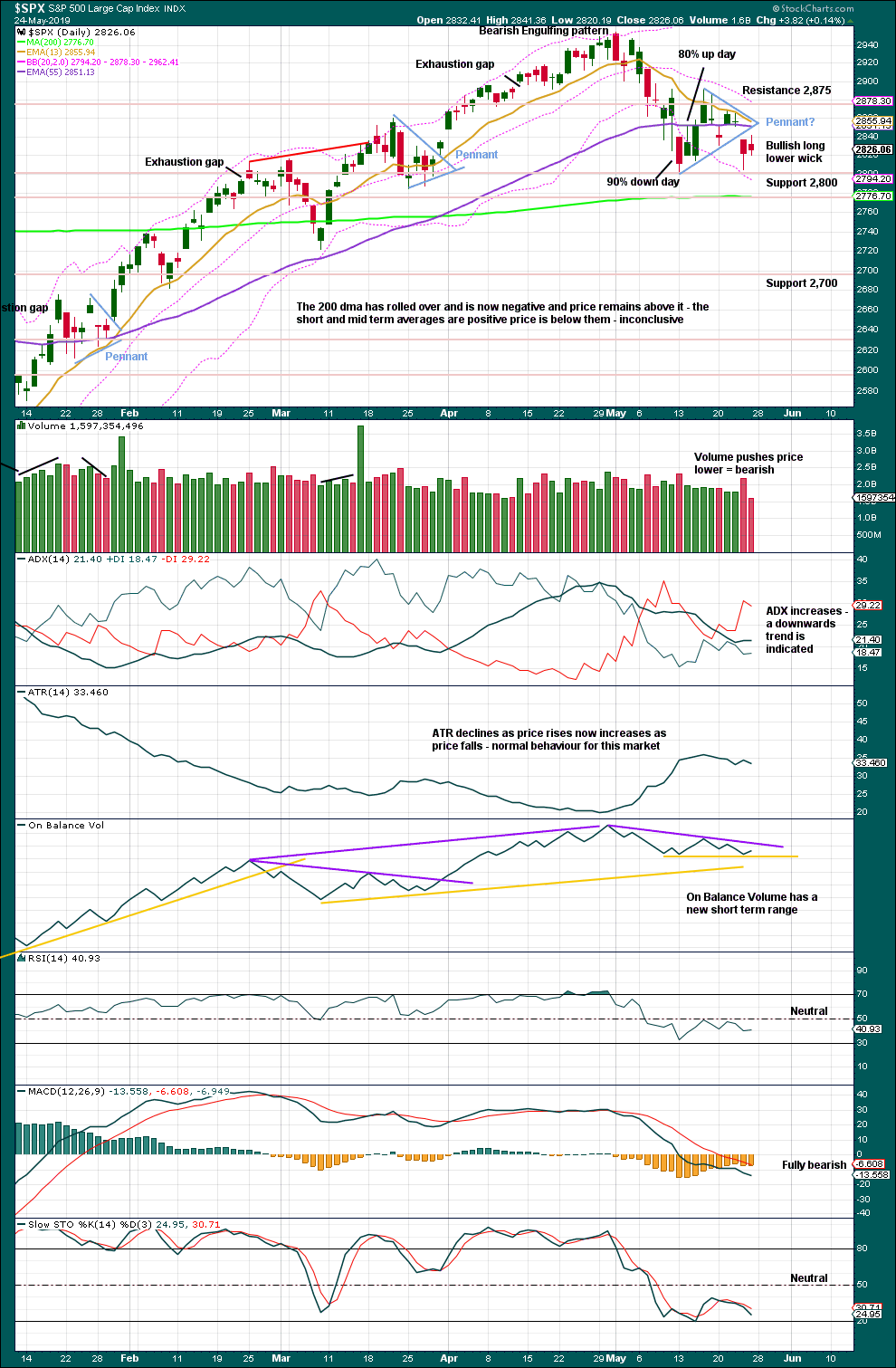
Click chart to enlarge. Chart courtesy of StockCharts.com.
A 90% downwards day at or immediately prior a low followed immediately afterwards by a 90% upwards day is a strong indication of a low in place. The indication is weaker in this case, but the movement is also weaker. The 80% upwards day of the 14th of May shows an almost 180 degree shift in sentiment after the 90% downwards day immediately prior. This is a pattern seen at minor lows. However, upwards movement following the low has not developed strong demand needed to produce a sustained rally. There is now less support for the view that a mid-term low is in place.
The dominant trend is up. Pullbacks in an upwards trend should be used as opportunities to join the trend.
Watch On Balance Volume carefully again next week. A breakout would provide a weak signal that may add a little confidence to the next move from price.
A small pennant pattern may be complete and followed by a downwards breakout, which has support from volume. The target is about 2,690.
BREADTH – AD LINE
WEEKLY CHART
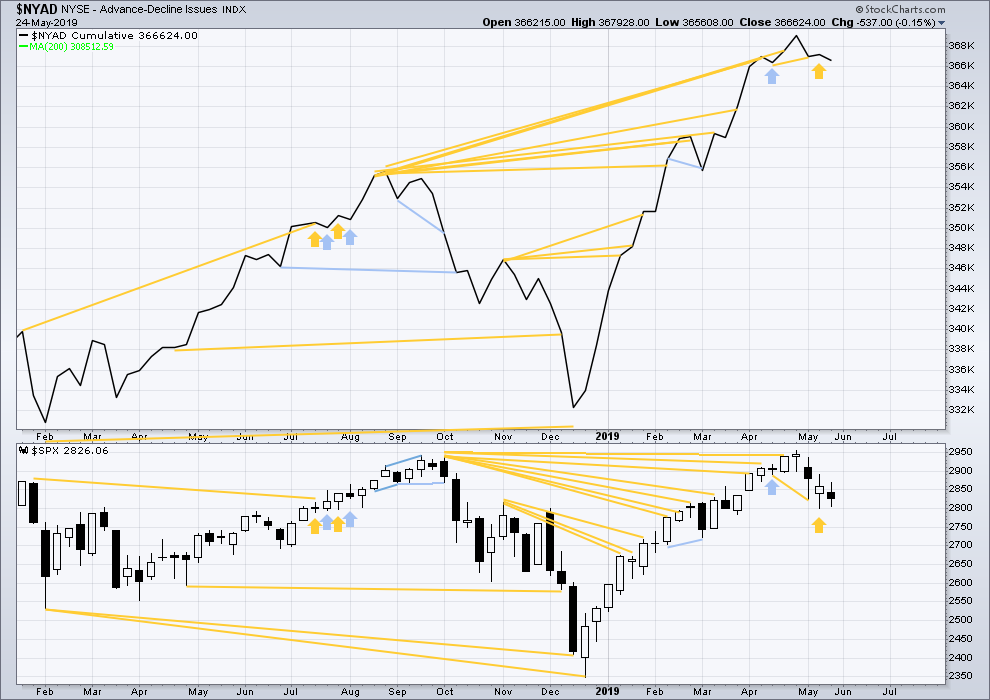
Click chart to enlarge. Chart courtesy of StockCharts.com. So that colour blind members are included, bearish signals
will be noted with blue and bullish signals with yellow.
Bear markets from the Great Depression and onwards have been preceded by an average minimum of 4 months divergence between price and the AD line with only two exceptions in 1946 and 1976. With the AD line making a new all time high on the 3rd of May, the end of this bull market and the start of a new bear market is very likely a minimum of 4 months away, which is the beginning of September 2019.
This week price has moved sideways and the candlestick has closed red. A decline in breath this week supports downwards movement within the week. There is no short-term divergence.
This week all of small, mid and large caps moved sideways.
DAILY CHART
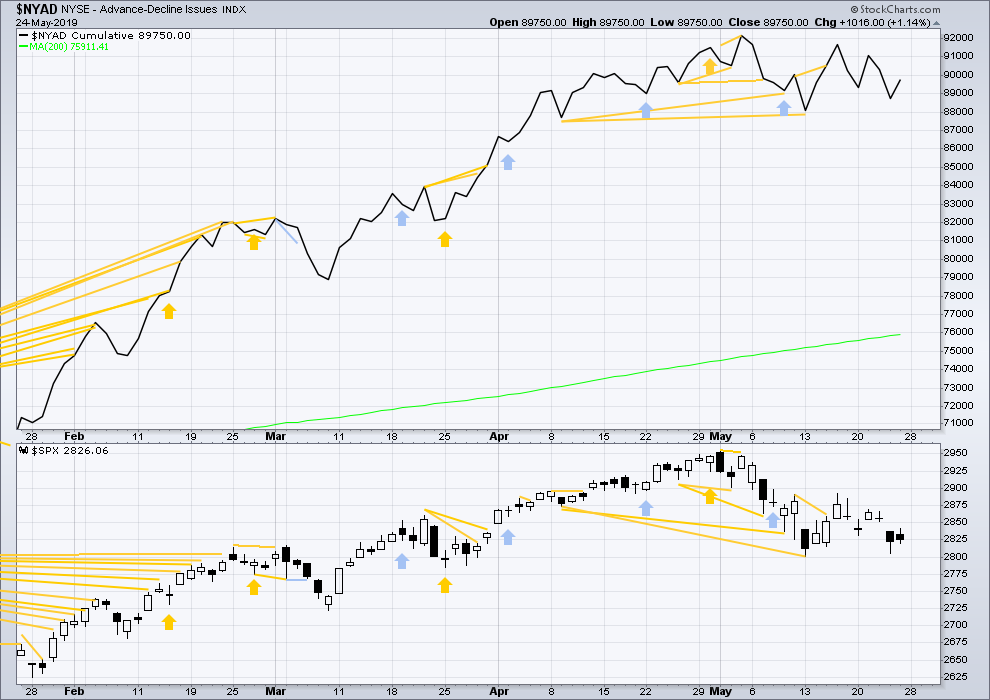
Click chart to enlarge. Chart courtesy of StockCharts.com. So that colour blind members are included, bearish signals
will be noted with blue and bullish signals with yellow.
Breadth should be read as a leading indicator.
Mid-term bullish divergence remains and supports the view here that a low may be in place.
On Friday both price and the AD line have moved higher. There is no new short-term divergence.
VOLATILITY – INVERTED VIX CHART
WEEKLY CHART
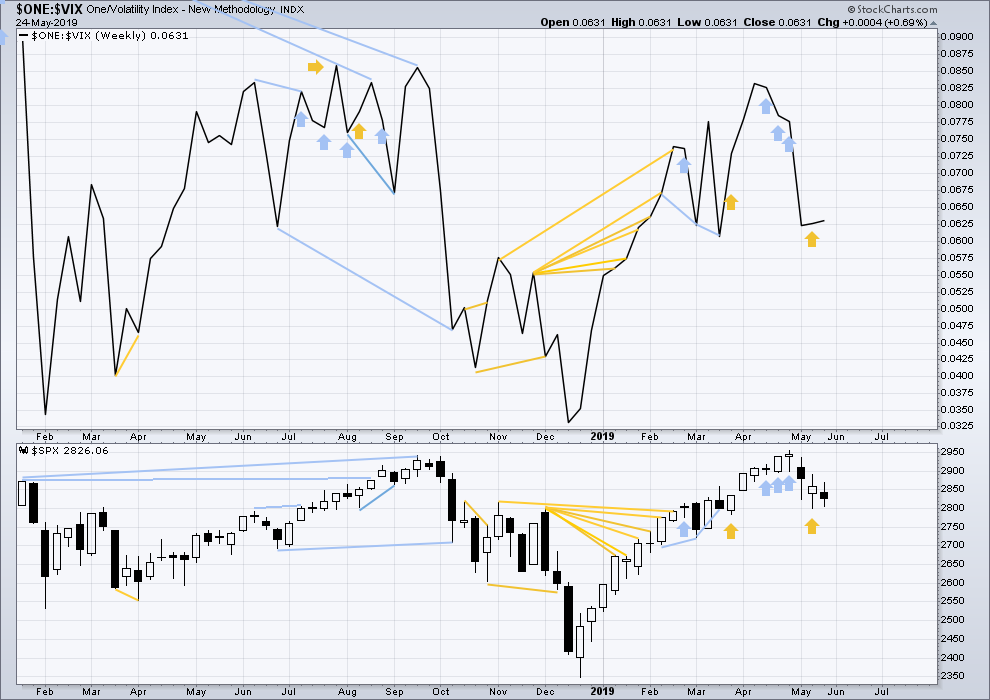
Click chart to enlarge. Chart courtesy of StockCharts.com. So that colour blind members are included, bearish signals
will be noted with blue and bullish signals with yellow.
Three weeks in a row of weekly bearish divergence has now been followed by two reasonable downwards weeks. It may be resolved here, or it may yet be an indication of further downwards movement in price.
This week price has completed an inside week. Inverted VIX has moved slightly higher. There is no short-term divergence.
DAILY CHART
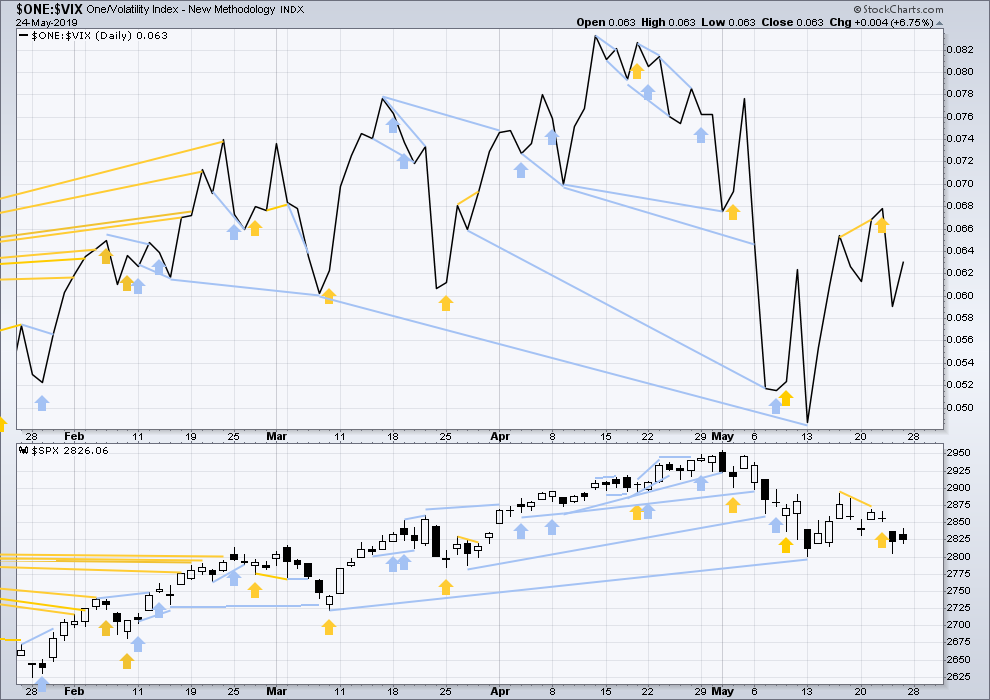
Click chart to enlarge. Chart courtesy of StockCharts.com. So that colour blind members are included, bearish signals
will be noted with blue and bullish signals with yellow.
On Friday price and inverted VIX both moved slightly higher. There is no short-term divergence.
DOW THEORY
Dow Theory confirmed a bear market in December 2018. This does not necessarily mean a bear market at Grand Super Cycle degree though; Dow Theory makes no comment on Elliott wave counts. On the 25th of August 2015 Dow Theory also confirmed a bear market. The Elliott wave count sees that as part of cycle wave II. After Dow Theory confirmation of a bear market in August 2015, price went on to make new all time highs and the bull market continued.
DJIA: 23,344.52 – a close on the 19th of December at 23,284.97 confirms a bear market.
DJT: 9,806.79 – price has closed below this point on the 13th of December.
S&P500: 2,532.69 – a close on the 19th of December at 2,506.96 provides support to a bear market conclusion.
Nasdaq: 6,630.67 – a close on the 19th of December at 6,618.86 provides support to a bear market conclusion.
With all the indices moving now higher, Dow Theory would confirm a bull market if the following highs are made:
DJIA: 26,951.81
DJT: 11,623.58
S&P500: 2,940.91 – a new all time high has been made on the 29th of April 2019.
Nasdaq: 8,133.30 – a new high has been made on 24th of April 2019.
Published @ 10:41 a.m. EST on May 25, 2019.
—
Careful risk management protects your trading account(s).
Follow my two Golden Rules:
1. Always trade with stops.
2. Risk only 1-5% of equity on any one trade.
—
New updates to this analysis are in bold.

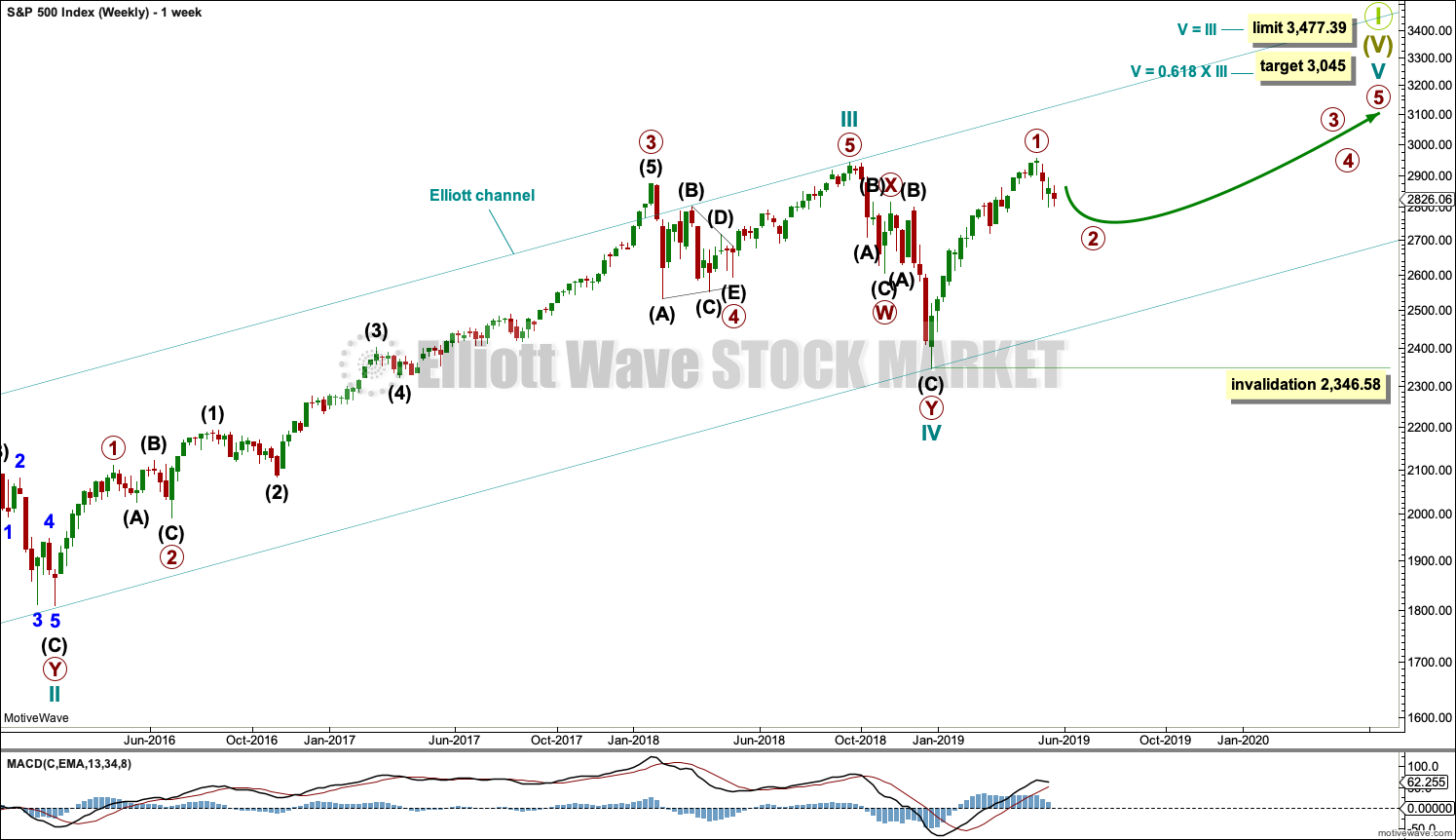
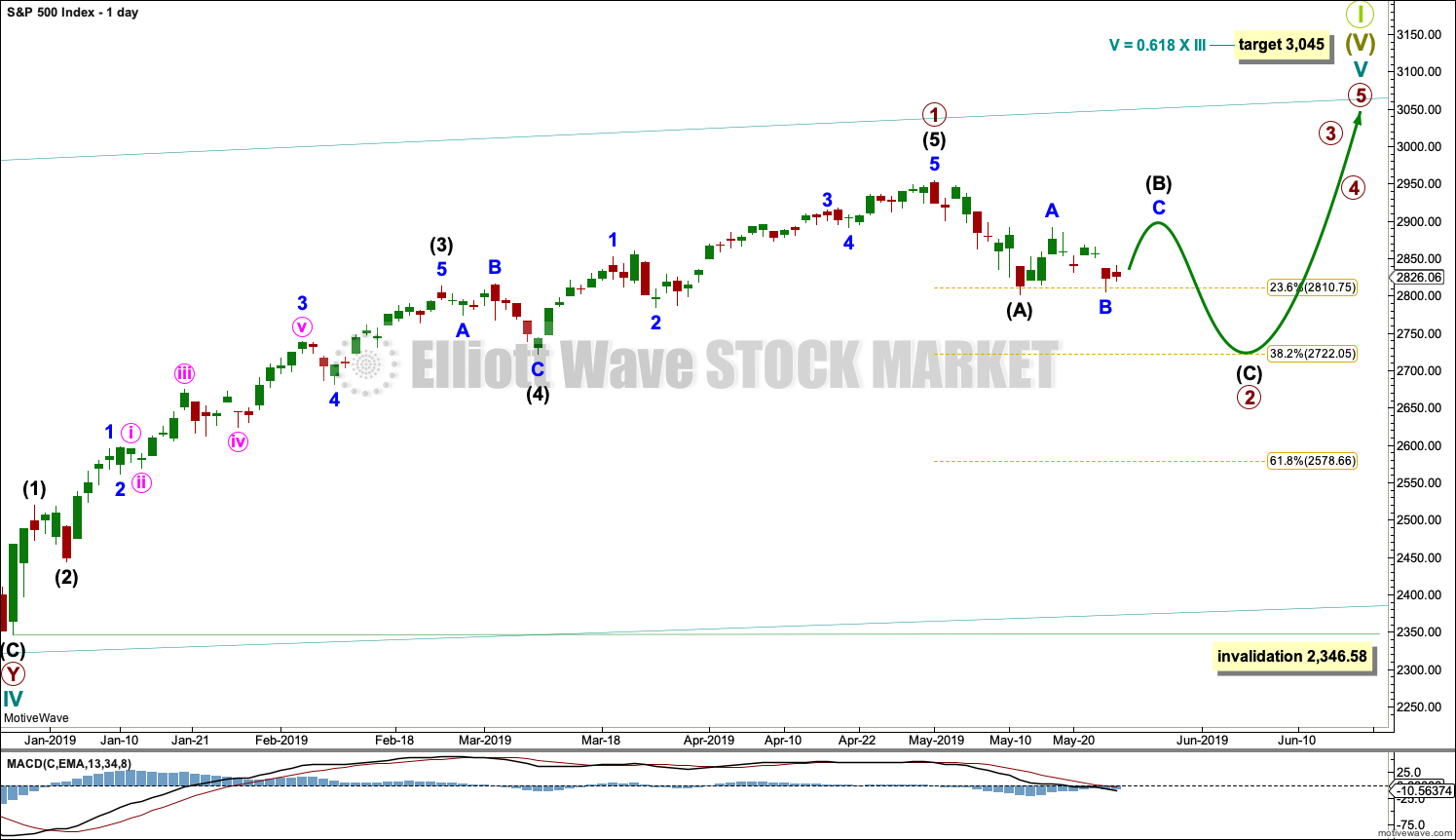
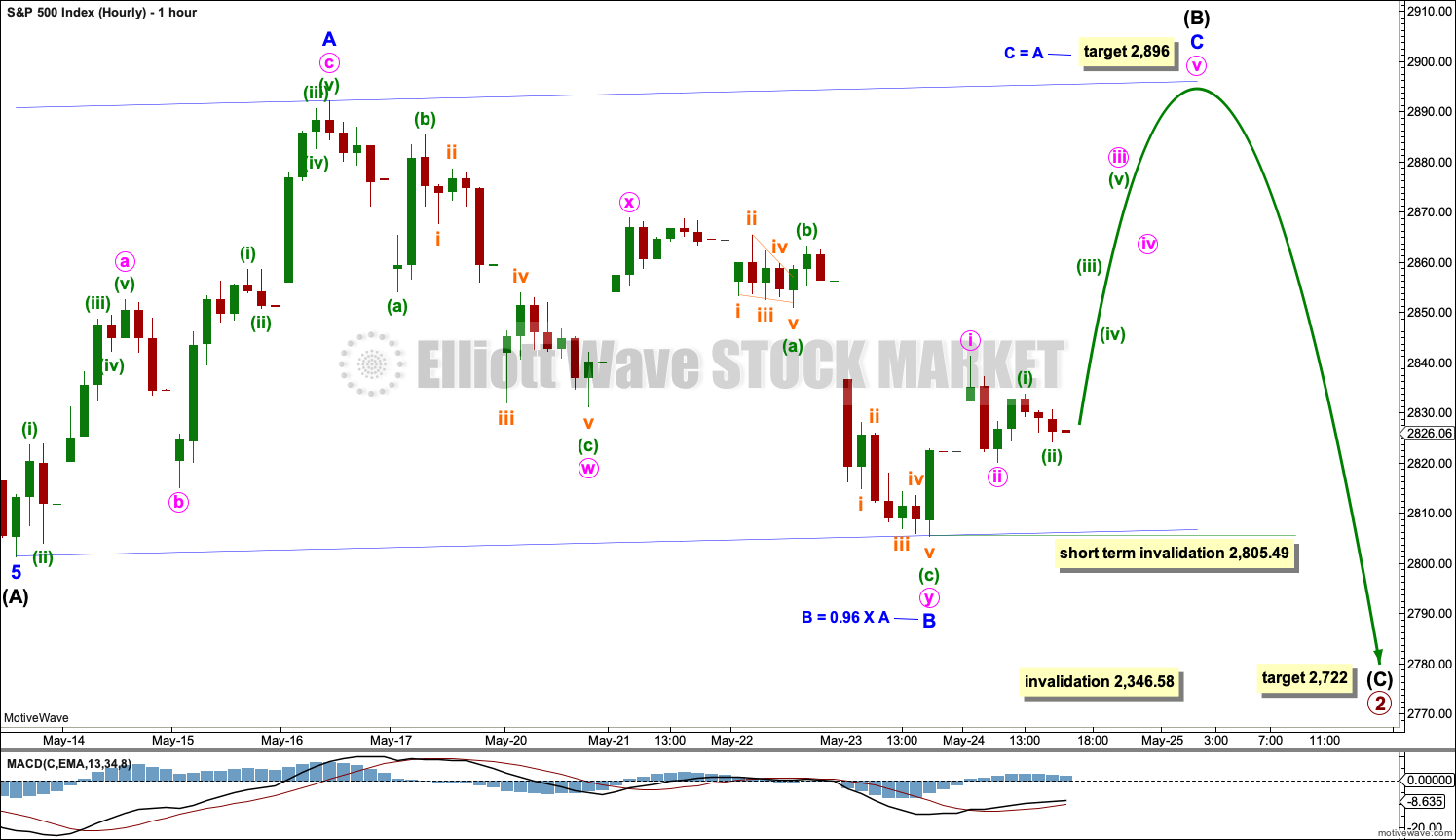
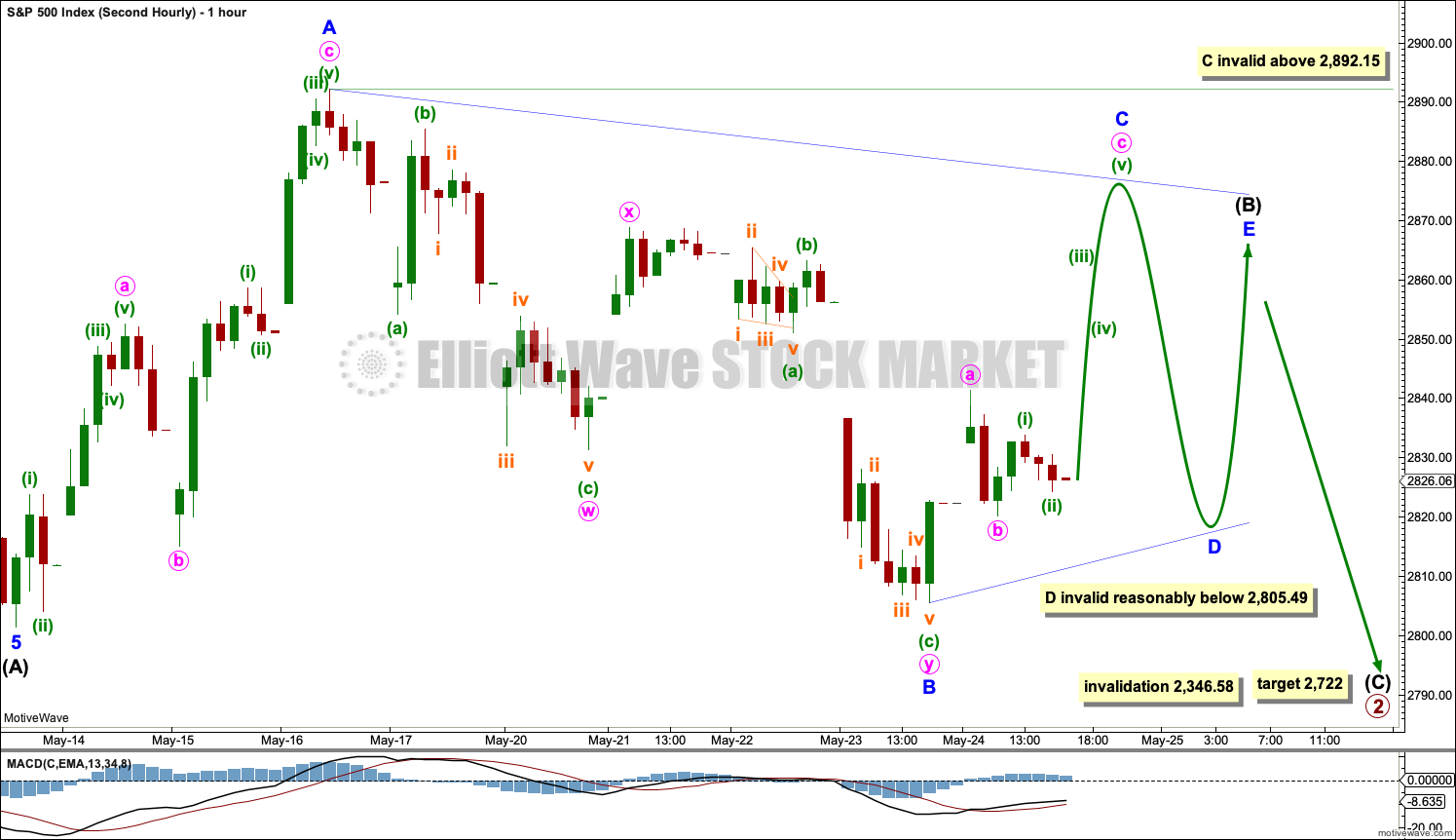
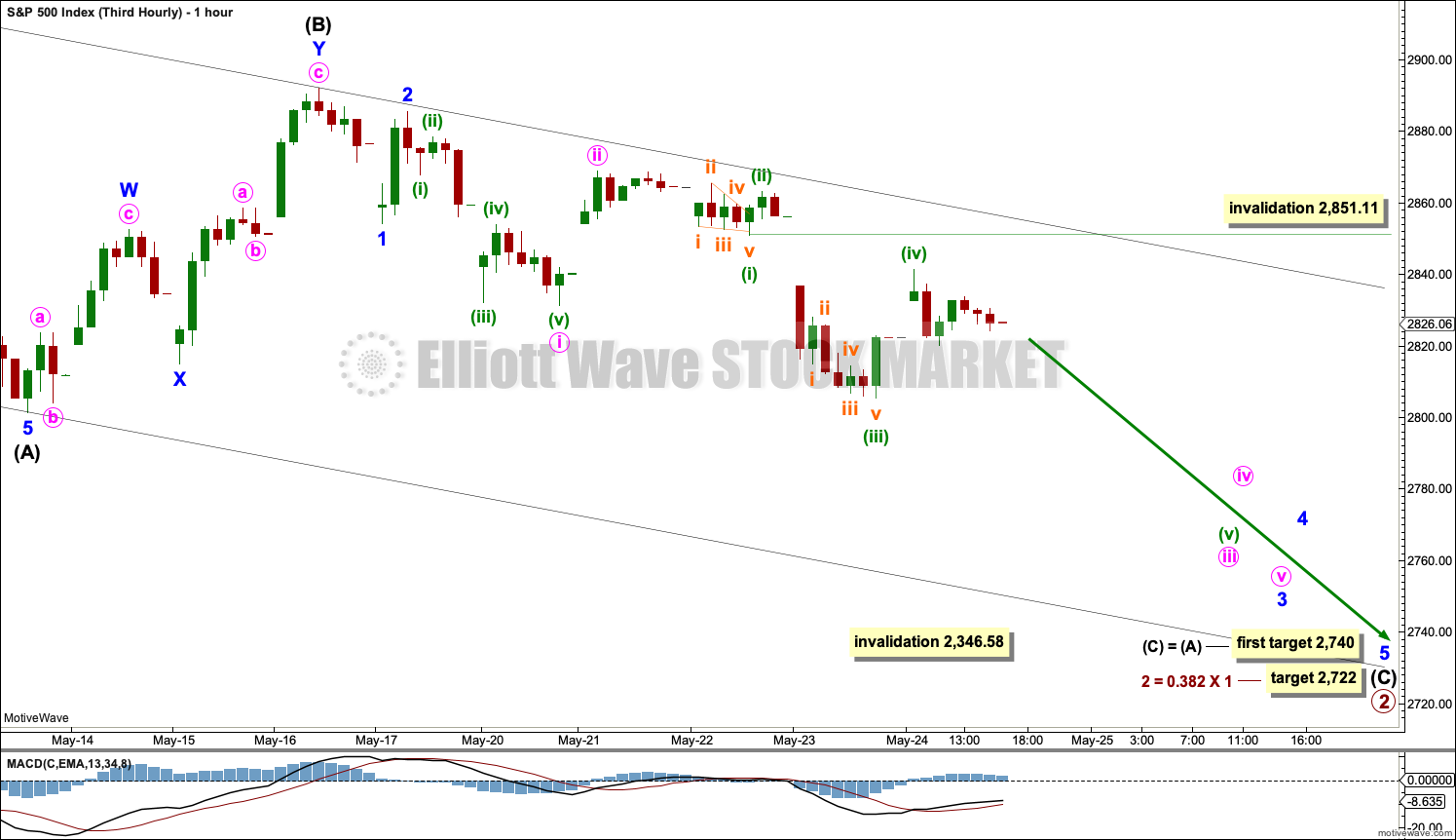
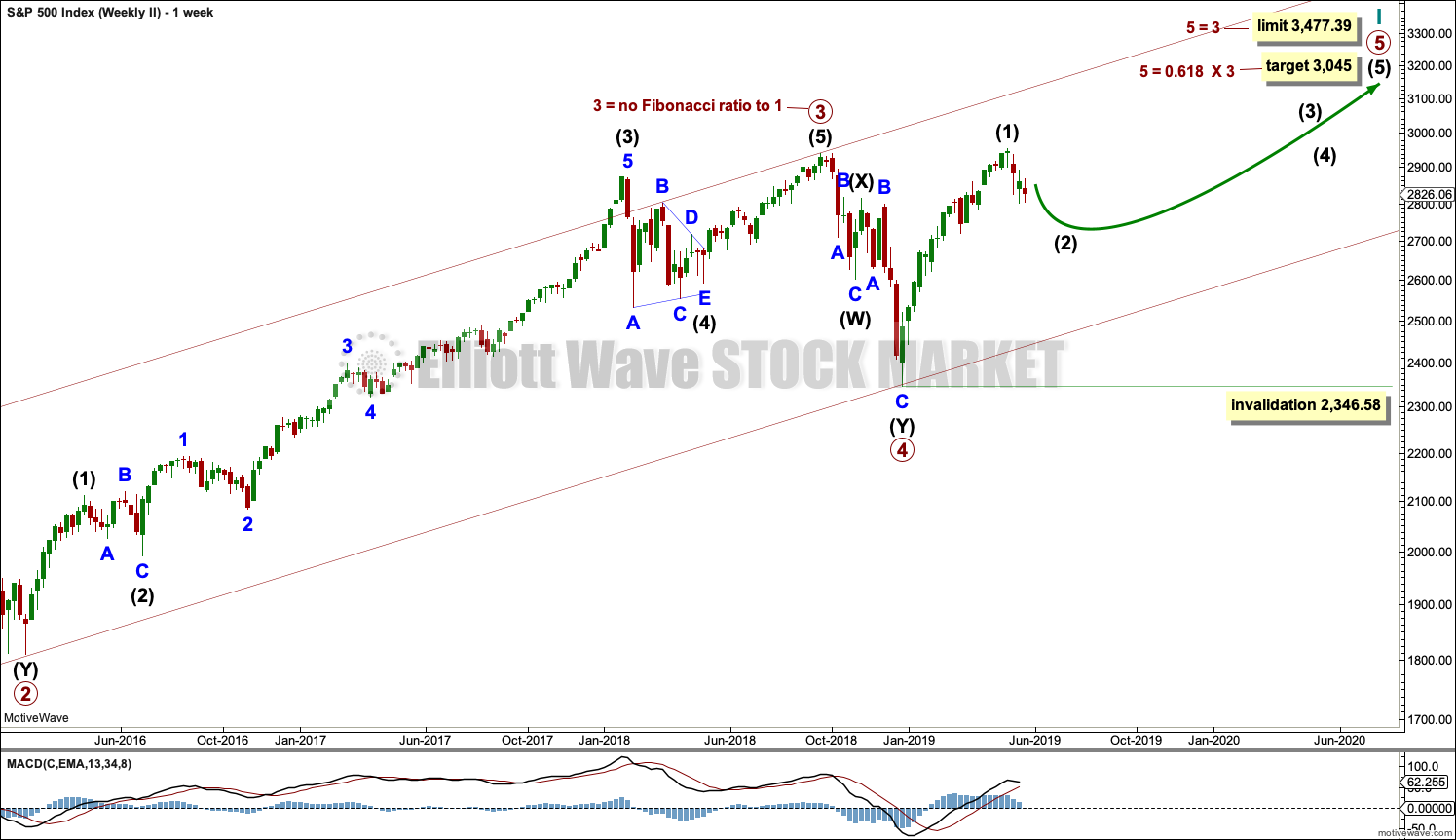
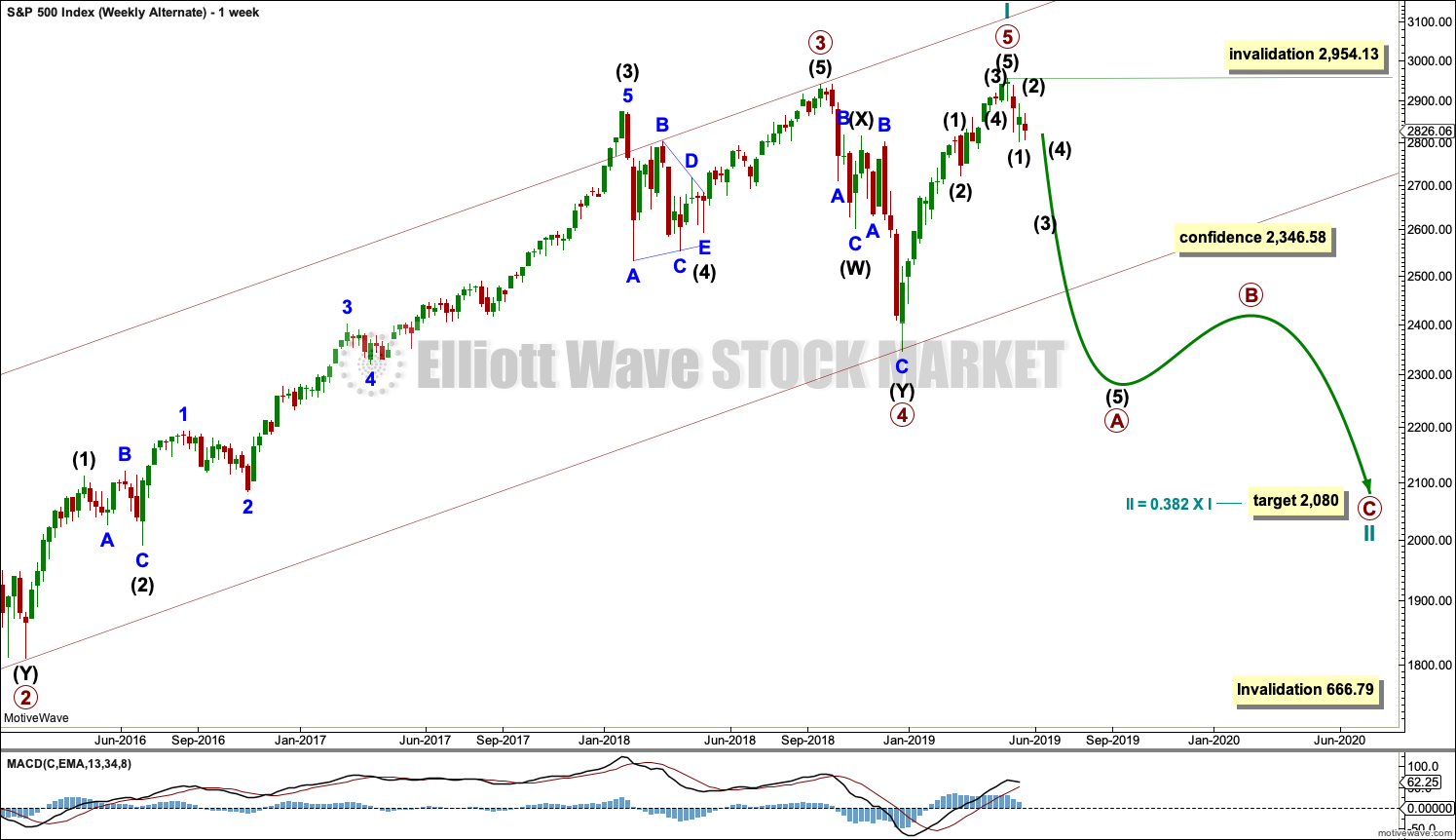
First hourly chart updated:
minute ii may not move beyond the start of minute i… however I can see a way to relabel the second zigzag within minor B as continuing lower, and minor B may move beyond the start of minor A as in an expanded, so the price point 2,805.49 cannot be a firm invalidation point for this count at this time
however, if price does move below 2,805.49 this count would reduce in probability
Second hourly chart updated:
For this count minor B may also move below the start of minor A as in a running triangle, so 2,805.49 cannot be a firm invalidation point at this time as I can see a way to relabel minor B as continuing lower as a double zigzag. The second zigzag may be incomplete.
however, a new low below 2,805.49 would reduce the probability of this count
Third hourly chart updated:
A new low now below 2,805.49 has increased the probability of this third count.
I’ll be shuffling the three counts around today, this will now be #1
Hey Lara! Dont mess with Texas! Their coffee gets mixed with dust and cow pie!
With bitcoin break out continuing, can you update your call with a 5th wave price target? Your current price analysis shows a possible 11-12k top out?
LOL
I gave up years ago trying to calculate targets for Bitcoin, it doesn’t work because it very rarely exhibits Fibonacci Ratios and when it does they are very extreme.
That makes target calculation impossible.
So sorry, I cannot do what you need. What I’m looking for in Bitcoin is the classic evidence of a high in place; vertical upwards movement for 2-4 weeks, strong volume then a decline on the last week, followed then by a bearish candlestick reversal pattern on the weekly and / or daily charts.
When I see that, I’ll expect a high in place.
Until that happens it’s safest to assume the trend remains the same, upwards.
hello
is there any elliot rule that would invalidate the theory that the 5 is done and that we are now in the bear market?
my first post, be gentle 🙂
I assume you’re referring to the new alternate weekly chart at the end of the Elliott wave analysis above?
Yes. Within the new downwards trend, a movement at cycle degree needs to complete a five down at the weekly chart level.
Within the new five down, the only two possible EW structures are an impulse or a leading diagonal. The rule for a second wave for both of these structures is the same. A second wave may not move beyond the start of a first wave.
And so a new all time high would invalidate that new alternate wave count.
NYSE is closed today for Memorial Day here in the USA, so your analysis will resume tomorrow.
So far I’m really enjoying Texas! Except… the coffee is… not very good. Shall remedy shortly.
I suspect the coffee issue in Texas is a coffee issue in the US in general. Weak, watery swill, quite often.
Oh dear, yes. NZ has a strong coffee culture, we have really good coffee everywhere. I have an espresso machine and conical burr grinder at home.
I have found one local place which does acceptably drinkable coffee. But when I get home, I’ll be hugging my coffee machine with real love.
I have a Gaggia Accademia….. we bought it for our 15th anniversary. I can highly recommend it.
I dabble with a home roaster as well, but my local guy is so good… makes mine seem likes its from Texas
First ….. one day in Texas, and Lara spots a bear!
Not only has she spotted a bear but she made this statement for the 1st time ever:
—————————————————————————————————–
Bear markets from the Great Depression and onwards have been preceded by an average minimum of 4 months divergence between price and the AD line with only two exceptions in 1946 and 1976.
—————————————————————————————————-
Lara, my question is about the two exceptions. Am I correct in that this is the first time you have mentioned 1946 and 1976? Did Lowry’s just discover and publish these dates? In my opinion, acknowledging these two dates significantly changes the absolute reliability of this indicator. If there are two exceptions, there can and most likely will be a third exception.
It was my mistake Rodney. I have been misinterpreting Lowry’s statements.
I was reading statements such as these:
“Historically, Adv-Dec Lines have begun to diverge from new
highs in the major price indexes on average 4-6 months prior
to the final market high”
and:
“Usually, the
negative shift in investor behavior is apparent when:
• For four or more months prior to the final market high, the
Adv-Dec Lines diverge from the major price indexes.”
to mean that it had NEVER happened. Which, thanks to Peter pointing it out, is not true.
And which also reinforces the adage that nothing in technical analysis is 100% true.
In the last 90 years there have been 17 bear markets (drops of 20% or more of market price). All but two were preceded by divergence between price and the AD line by a minimum of 1 months, maximum of 24 months, and average of 3.8 months.
In short, I got it wrong.
The balance of probability still points to a bear market not appearing here, but it is now a possibility that I must acknowledge.
Rod: I was always aware of the 1976 exception but never brought it up as the exception would not diminish Lara’s larger point regarding the significance of A/D line divergence. Having said that, the exception has always informed my own admittedly more bearish leanings when it comes to current advance, particularly in view of other confirming technical indicators. Now you know…! 🙂
If I’m getting something wrong Verne, feel free to point it out. That’s the only way we learn, by making mistakes and being open to correction.
I appreciate your attitude on this, Lara! Thank you for making wise and prudent adjustments when warranted.
Thanks Curtis. But, TBH, I’m pretty annoyed with myself and rather embarrassed that I made such a dumb mistake.
But I’ll console myself with the fact it may be early enough in the picture to give you all a wave count of a potential bear market.